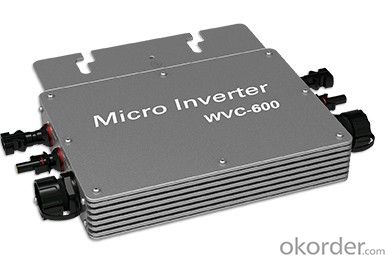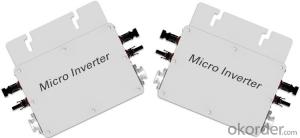KD-WVC600 Series Micro Inverter,Hot Sales
- Loading Port:
- China main port
- Payment Terms:
- TT OR LC
- Min Order Qty:
- 1000 pc
- Supply Capability:
- 100000 pc/month
OKorder Service Pledge
OKorder Financial Service
You Might Also Like
Structure
The transition from a centralized to a distributed inverter optimizes energy collection.
The converter module integrated into the solar panels can reduce installation costs.
Soft switch technology to replace hard-switching technology can improve efficiency and reduce heat dissipation.
From cottage industry to mass production, standardized design (hardware and software) to improve reliability and reduce costs.
Using a special capacitor (due to the high failure rate). Design requires a higher voltage to reduce the current, we use a special electrolytic capacitors.
The converter can be connected to the grid to eliminate the need for many battery applications. The high price of batteries, require maintenance, life expectancy is shorter.
Work required micro-inverter power increasingly smaller (only a few hundred watts), which can reduce the internal temperature and improve reliability.
Micro-inverter solar inverter system needs to deal with a lot of a particular power level, in order to increase production, thereby reducing costs.
DC input voltage range:
22-50VDCAC
output voltage range:80-160VAC/180-260V
ACAC output power :600Wp
AC frequency range:50Hz/60Hz
G.W.:2.85kg
Size:289mm*200mm*38mm
KD-WVC295 Series Using IP67 waterproof streamline design, Can effectively prevent rainwater on the surface erosion, Built-in high-performance Maximum Power Point Tracking(MPPT)Function,Better able to track changes in the solar luminosity and control different output power, Effectively capture and collect sunlight. AC electric power transmission using the reverse transmission technology, Is one of our patented technology, The inverter output power can provide load priority use, Extra electricity to the grid, Efficient use of the inverter to the power emitted, Electricity transmission rate of up to 99%.
Features
Pure Sine Wave Output;
High performance Maximum Power Point Tracking(MPPT);
Power Automatically Locked(APL);
Reverse power transmission;
High-Frequency High Conversion Rate;
Anti-Islanding Protect;
Input /output is fully isolated to protect the electrical safety;
Multiple parallel stacking;
The Leading Patent Technology;
IP65 WaterProof;
Flexible Installation;
Simplify maintenance (user serviceable)
High Efficiency & Best Cost-Effectiveness
Using a special capacitor (due to the high failure rate). Design requires a higher voltage to reduce the current, we use a special electrolytic capacitors.
The converter can be connected to the grid to eliminate the need for many battery applications. The high price of batteries, require maintenance, life expectancy is shorter.
Work required micro-inverter power increasingly smaller (only a few hundred watts), which can reduce the internal temperature and improve reliability.
Images


Specification
Input Data | KD-WV250-120VAC/230VAC | |||
Recommended input power | 200-300Watt | |||
Recommend the use of PV modules | 300W/Vmp>34V/Voc<50v< span=""> | |||
Maximum input DC voltage | 50V | |||
Peak power tracking voltage | 25-40V | |||
Operating Voltage Range | 17-50V | |||
Min / Max start voltage | 22-50V | |||
Maximum DC short current | 15A | |||
Maximum Input Current | 9.8A | |||
Output Data | @120VAC | @230VAC | ||
Peak power output | 260Watt | 260Watt | ||
Rated output power | 250Watt | 250Watt | ||
Rated output current | 2.08A | 0.92A | ||
Rated voltage range | 80-160VAC | 180-260VAC | ||
Rated frequency range | 57-62.5Hz | 47-52.5Hz | ||
Power factor | >96% | >96% | ||
Maximum units per branch circuit | 15PCS(Single-phase) | 30PCS(Single-phase) | ||
Output Efficiency | @120VAC | @230VAC | ||
Static MPPT efficiency | 99.5% | 99.5% | ||
Maximum output efficiency | 92.3% | 94.6% | ||
The average efficiency | 91.2% | 93.1% | ||
Night time power consumption | <50mW Max | <70mW Max | ||
THDI | <5%< span=""> | <5%< span=""> | ||
Exterior | ||||
Ambient temperature | -40°C to +60°C | |||
Operating temperature range (inverter inside) | -40°C to +82°C | |||
Dimensions (WxHxD) | 191mm*1176mm*38mm | |||
Weight | 0.83kg | |||
Waterproof Rating | IP65 | |||
Cooling | Self-cooling | |||
Feature | ||||
Power transmission mode | Reverse transfer, load priority | |||
Electromagnetic compatibility | EN50081.part1EN50082.part1 | |||
Grid disturbance | EN61000-3-2 Safety EN62109 | |||
Grid detection | DIN VDE 1026 UL1741 | |||
Certificate | CEC,CE National patent technology | |||
FAQ
Can we visit your factory?
Surely, I will arrange the trip basing on your business schedule.
Can you do OEM for us?
Yes, we can.
How do you pack your products?
We have rich experience on how to pack the panels to make sure the safety on shipment when it arrives at the destination.
Can you help us install the module if we cooperate with you?
We haven’t entered into installation sector, but we have the plan in near future.
- Q:Is it possible to upgrade my existing solar inverter without replacing the entire system?
- Yes, it is possible to upgrade an existing solar inverter without replacing the entire system. In many cases, solar inverters can be upgraded by simply replacing the existing inverter with a newer model that offers more advanced features or higher capacity. However, it is important to consult with a professional solar installer to determine the compatibility of the new inverter with your current system and ensure a successful upgrade.
- Q:Can a solar inverter be controlled remotely?
- Yes, a solar inverter can be controlled remotely. With the help of advanced monitoring systems and communication technologies, users can remotely access and control their solar inverters. This allows for convenient monitoring of power generation, performance optimization, and troubleshooting from any location with internet connectivity.
- Q:Can a solar inverter be installed in a residential area?
- Yes, a solar inverter can be installed in a residential area. In fact, it is common for residential homes to have solar inverters installed as part of a solar energy system to convert the direct current (DC) generated by the solar panels into alternating current (AC) that can be used to power household appliances and lighting.
- Q:Can a solar inverter be used in conjunction with a wind turbine?
- Yes, a solar inverter can be used in conjunction with a wind turbine. Both solar and wind energy sources produce direct current (DC) electricity, which needs to be converted to alternating current (AC) for use in homes and businesses. A solar inverter is designed to convert DC electricity generated from solar panels into AC electricity, and it can also be utilized to convert the DC electricity generated by a wind turbine into usable AC electricity. By integrating a solar inverter, the electricity generated by both the solar panels and wind turbine can be synchronized and fed into the electrical grid or used directly on-site.
- Q:Can a solar inverter be used in areas with high levels of electromagnetic interference (EMI)?
- Yes, a solar inverter can be used in areas with high levels of electromagnetic interference (EMI) as long as the inverter is designed and tested to withstand such conditions. Inverters with robust shielding and advanced filtering mechanisms can effectively mitigate the effects of EMI, ensuring stable and reliable operation even in challenging electromagnetic environments.
- Q:What is the maximum AC current output of a solar inverter?
- The maximum AC current output of a solar inverter depends on its size and rating. It can range from a few amps to several hundred amps, typically ranging between 5-100 amps for residential inverters and going up to higher currents for commercial or utility-scale inverters.
- Q:How does a solar inverter synchronize with the electrical grid?
- A solar inverter synchronizes with the electrical grid by constantly monitoring the grid's voltage and frequency. It adjusts its own output voltage and frequency to match those of the grid, ensuring seamless integration and safe operation. This synchronization process allows the solar inverter to feed power into the grid and maintain grid stability.
- Q:Can a solar inverter be used in a mobile or portable solar system?
- Yes, a solar inverter can be used in a mobile or portable solar system. In fact, it is a crucial component that converts the direct current (DC) generated by the solar panels into alternating current (AC) that can be used to power various devices and appliances. Portable solar systems often include a built-in inverter, allowing them to provide convenient and clean energy on the go.
- Q:Are there any limitations on the angle of the solar panels when using a solar inverter?
- Yes, there are limitations on the angle of the solar panels when using a solar inverter. The angle at which solar panels are installed can affect their efficiency and overall performance. Ideally, solar panels should be installed at an angle that allows them to receive maximum sunlight throughout the day. Most solar panels are designed to work optimally when installed at an angle that is equal to the latitude of the location. This angle allows the panels to capture the most sunlight during peak hours. However, this is not a strict rule and variations are possible depending on the specific location and climate conditions. If solar panels are installed at an angle that is too steep or too shallow, it can result in reduced energy production. Steep angles may cause the panels to lose sunlight during certain times of the day, while shallow angles may not allow for optimal sunlight absorption. Additionally, extreme angles can also increase the risk of damage from wind or other weather conditions. It is important to note that modern solar inverters often come with advanced tracking and monitoring technologies that can adapt to different panel angles and orientations. These features can optimize energy production by adjusting the inverter settings based on the real-time performance of the panels. Overall, while there are limitations on the angle of the solar panels, it is crucial to ensure that they are installed in a way that maximizes their exposure to sunlight throughout the day to achieve the highest energy production possible.
- Q:What is the role of frequency support in a solar inverter?
- The role of frequency support in a solar inverter is to ensure that the electricity generated by the solar panels is synchronized with the frequency of the electrical grid. This support is necessary to maintain grid stability and prevent any disruptions caused by fluctuations in frequency. The solar inverter monitors the grid frequency and adjusts the output of the solar panels accordingly, either by increasing or decreasing the power generation, to match the grid's frequency requirements.
1. Manufacturer Overview |
|
|---|---|
| Location | |
| Year Established | |
| Annual Output Value | |
| Main Markets | |
| Company Certifications | |
2. Manufacturer Certificates |
|
|---|---|
| a) Certification Name | |
| Range | |
| Reference | |
| Validity Period | |
3. Manufacturer Capability |
|
|---|---|
| a)Trade Capacity | |
| Nearest Port | |
| Export Percentage | |
| No.of Employees in Trade Department | |
| Language Spoken: | |
| b)Factory Information | |
| Factory Size: | |
| No. of Production Lines | |
| Contract Manufacturing | |
| Product Price Range | |
Send your message to us
KD-WVC600 Series Micro Inverter,Hot Sales
- Loading Port:
- China main port
- Payment Terms:
- TT OR LC
- Min Order Qty:
- 1000 pc
- Supply Capability:
- 100000 pc/month
OKorder Service Pledge
OKorder Financial Service
Similar products
New products
Hot products
Hot Searches
Related keywords






























